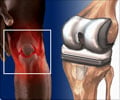Osteoarthritis is the most common joint disease affecting middle-aged and older people. It is characterized by progressive damage to the joint cartilage.

‘Osteoarthritis, or OA, is the most common joint disease affecting middle-aged and older people. It is characterized by progressive damage to the joint cartilage.’





Existing OA therapies address joint pain and function, but they may only have limited efficacy. There are also questions about their long-term safety for patients, said Yusuf Yazici, MD, Chief Medical Officer of Samumed, LLC, a biotech in San Diego, Calif., which conducted new research about Wnt inhibitors. Recent research shows that the Wnt signaling pathway plays a role in the formation of joint tissues, and suggests that an altered Wnt pathway is associated with cartilage loss. "Osteoarthritis is a debilitating disease affecting nearly 30 million patients in the U.S. alone," said Dr. Yazici. The goals for his laboratory's research are "to develop a disease-modifying treatment which will regrow cartilage, while also safely treating the signs and symptoms of this significant patient population."
In a 24-week, multicenter, single-dose-escalation, randomized controlled trial, the researchers measured the impact of a single, intra-articular injection of SM04690, a Wnt inhibitor, on pain and function in 61 patients with moderate to severe knee OA. The drug's efficacy was analyzed through Outcomes Measures in Rheumatology (OMERACT)-Osteoarthritis Research Society International (OARSI) strict responder data.
"Our impetus for the trial was to analyze OMERACT-OARSI responses to further test the clinical relevance of the signs and symptoms data we had observed," said Dr. Yazici. "SM04690 has the potential for true disease modification, and relief of signs and symptoms for OA patients."
The average age of the study subjects was 62.6 (±5.7) years, 67 percent were female, and their average body-mass index was 30.4 (±4.7). Escalation cohorts of 20 patients each, including 16 active and four placebo) were given a dose of SM04690 at 0.03 mg, 0.07 mg and 0.23 mg in a 2 mL injection. Subjects were given one injection into their affected knee on the first day, and participated in a follow-up period of 24 weeks.
Advertisement
Compared to placebo, the researchers found statistically more OMERACT-OARSI strict responders in the 0.07 mg cohort at week 12, or 76 percent versus 36 percent, P=0.04. Numerically, there were more strict responders in the 0.03 mg cohort at week 24, or 73 percent versus 36 percent, P=0.07. More patients in the 0.07 mg cohort met both the pain and function criteria versus placebo at 12 and 24 weeks. Responses in the 0.23 mg cohort were 44 percent at week 12 and 25 percent at week 24.
Advertisement
"More patients treated with a single, intra-articular injection of SM04690 than placebo achieved a significant OMERACT-OARSI strict response, a composite score of clinical efficacy requiring both absolute and relative improvement," he said. "Through further analysis, we saw that the clinical response was driven by improvements in both pain and function measurements from baseline as 12 and at 24 weeks, and not solely by one or the other, suggesting clinically relevant, multidimensional improvement."
The researchers also explored the potential efficacy of Wnt inhibitors on joint space narrowing and cartilage loss, two signs of worsening arthritis. "A therapy with the potential to not only decrease pain and improve function for patients with knee OA, but also to halt or reverse the processes that are driving disease progression, would be a welcome addition to the OA treatment armamentarium," said Dr. Yazici.
The researchers examined their data to evaluate the change from baseline in joint space width (JSW) on X-rays, and then conducted an analysis of JSW change using repeated measures analysis of covariance, or ANCOVA, adjusting for baseline JSW in the modified intention-to-treat (mITT) population.
In the mITT population at 24 weeks, subjects in the 0.07 mg cohort showed statistically significant increase in mean medial JSW of 0.49 mm (SD ±0.75 mm, P=0.02) from baseline compared to placebo. No change in mean medial JSW was observed in the 0.03 mg cohort (mean 0.00 mm, SD ±0.69 mm), a decrease in mean medial JSW of 0.15 mm (SD ±1.07 mm) observed in the 0.23 mg cohort and a mean decrease of 0.33 mm (SD ±0.87 mm) observed in the placebo cohort.
These results, based on exploratory X-ray outcomes from the study, suggest that treatment with SM04690 may maintain or increase joint space width compared to placebo, said Dr. Yazici.
"SM04690 has a novel mechanism of action, and the findings so far suggest that it's safe and has the potential for true disease modification, as well as relief of signs and symptoms of OA after a single injection," he said. "Radiographs (X-rays) taken at baseline and at 24 weeks post-injection suggested that mean joint space width was maintained in one dose, and even increased in another dose."
The next steps are to further assess Wnt inhibitors' safety and efficacy, said Dr. Yazici. The researchers are now conducting a Phase II trial on patients with moderate to severe knee OA.
"Most importantly, we hope that SM04690 will continue to show positive safety and efficacy so that the millions of patients with knee OA will have a new treatment option," he said.
Source-Eurekalert










